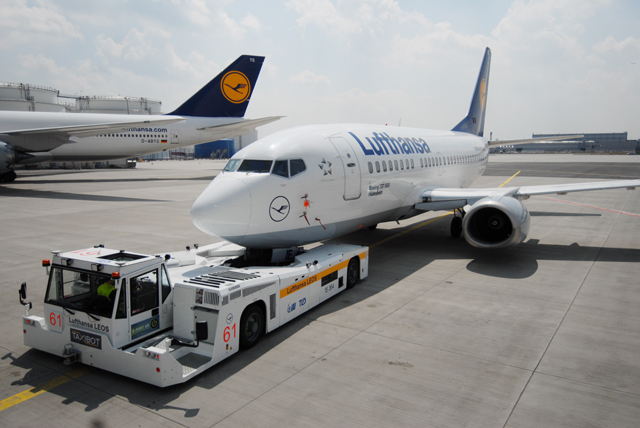Israel Aerospace Industries and Lufthansa Technik's ground services unit LEOS have signed a tentative agreement to jointly conduct certification tests for an in-development widebody version of IAI's pilot-controlled tow tractor TaxiBot with a Boeing 747.
Last year, the parties completed certification trials for the semi-robotic vehicle's existing narrowbody variant with a decommissioned Lufthansa 737-500 at Frankfurt airport. Now, they plan to extend their co-operation to undertake similar tests with a 747-400 in the autumn.
Certification of the 12-wheel tug, which will be capable of towing aircraft of the Airbus A380's size, is set for early 2016, said IAI executive vice-president Yehoshua Eldar during a media briefing in Frankfurt on 19 February. The hybrid-powered vehicle was built by French tug manufacturer TLD – which also produced the narrowbody version – and started drive tests last year.
The main objective of employing a tug for taxiing instead of the aircraft engines is to reduce fuel consumption and noise on the ground. IAI estimates that the use of TaxiBot can deliver an 85% fuel saving during taxiing, while noise and probability of engine damage through foreign object debris ingestion are halved.
Whether Frankfurt airport will be used again for the certification trials is not yet clear. The hub is being evaluated as location for the trials in addition to a number of other gateways, says LEOS innovation director Gerhard Baumgarten.

Lufthansa will provide a 747-400 for the project. The aircraft will not need to be de-registered, but fitted with a bespoke nose wheel leg equipped with strain gauges to measure loads during the trial. The airline has not yet decided whether to sell, part out or return the aircraft to service after the test, it says.
Last year, IAI and Air France signed a similar memorandum of understanding to study and potentially test widebody towing operations with TaxiBot at Paris Charles de Gaulle airport during the second quarter of 2015. This will be complementary to the trial with the 747 as it will involve other aircraft types such as the 777, A330 or A340, says IAI programme director Ran Braier.
Meanwhile, Lufthansa is testing the narrowbody TaxiBot – certificated by European and Israeli regulators in November 2014 – for regular passenger flights with the airline's 737 fleet in Frankfurt. The six-month operational trial will continue until May.
Pilots use the tug to taxi from the aircraft stand to the runway. Today, the trial only covers flights departing from Frankfurt's runway 18, as the taxiways in that vicinity provide enough space to detach the tractor without holding up any other aircraft. But discussions are under way with airport operator Fraport to potentially extend the trial to flights departing from other runways, says Baumgarten.
Lufthansa is also evaluating potential engine starts during taxi operations. That will not be possible for the airline's classic-generation 737 fleet as the aircraft are not equipped for automated engine starts. Pilots have to manually manage the start procedure, which would be unsafe to attempt when one pilot is looking outside to taxi the aircraft.
First officer Raphael Gabel says the current practice of starting the engines while TaxiBot is detaching from the aircraft is not creating any significant delay. As the detachment takes about a minute, one of the two engines is usually running stable when the tractor moves away from the aircraft. The CFM International CFM56-powered 737 requires two minutes of engine warm-up time before take-off, he says.
Aside from saving fuel and avoiding noise, the practice of towing aircraft to the runway has improved ground traffic flow around the airport's terminal, says LEOS managing director Peter Unger. In conventional operations, engines are started after push-back from the stand, so there is a certain time period before the aircraft can taxi under own power, which can cause hold-ups for other aircraft in the vicinity. Such congestion is reduced if departing aircraft can move ahead straight after push-back, Unger says. Ground vehicle traffic can also be improved as there is no jet blast from engines of taxiing aircraft.

Lufthansa
The benefits of employing alternative taxi procedures, such as TaxiBot, can be significant at large and busy airports, says Unger. But this may be less relevant at smaller gateways with short taxi distances, he says.
Lufthansa is phasing out its 737s, with the last of the twinjets set to retire in 2016 or, at the latest, 2017.
Airbus and IAI trialled a prototype of the tractor with an ex-British Airways A320 at Chateauroux airport in France in 2012, and has since completed practical tests for a no-technical-objection (NTO) approval by the airframer. In October 2014, IAI said that the approval should "soon" be extended to the European twinjet.
LEOS envisions a potential fleet of up to nine TaxiBot tractors to conduct 60-70% of taxi operations from aircraft stands to the runway for the parent carrier's narrowbody fleet, says Unger. But the group has not disclosed any timeline for that initiative. Taxi-in operations for arriving aircraft are not planned today, he says.
Source: Cirium Dashboard























